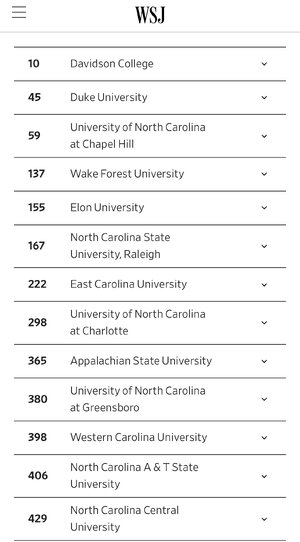Navigation
Install the app
How to install the app on iOS
Follow along with the video below to see how to install our site as a web app on your home screen.
Note: This feature may not be available in some browsers.
More options
You are using an out of date browser. It may not display this or other websites correctly.
You should upgrade or use an alternative browser.
You should upgrade or use an alternative browser.
WSJ College Rankings 2024 / US News Rankings better for ACC schools
- Thread starter nycfan
- Start date
- Replies: 64
- Views: 2K
- Messages
- 34,369
Among ACC:
3 Stanford
8 Cal
9 GaT
17 Notre Dame
19 Va Tech
33 UVa
45 dook
59 UNC
——
A lot of oddities in these rankings (top 20 includes Babaon College, Bentley, Lehigh, San Jose State and Harvey Mudd College) but having Texas A&M (28) ranked above UVa, dook and UNC (not to mention Texas) throws their entire methodology into question IMO.
3 Stanford
8 Cal
9 GaT
17 Notre Dame
19 Va Tech
33 UVa
45 dook
59 UNC
——
A lot of oddities in these rankings (top 20 includes Babaon College, Bentley, Lehigh, San Jose State and Harvey Mudd College) but having Texas A&M (28) ranked above UVa, dook and UNC (not to mention Texas) throws their entire methodology into question IMO.
HeelInTheOzarks
Honored Member
- Messages
- 865
Texas A&M above UNC and Duke? My gosh lol
- Messages
- 34,369
salary impact is 33%
Time to payoff cost is 17%
graduation rate 20%
Learning environment 20% (equal parts opportunities, career prep, facilities, students there recommend going there, character score)
Diversity 10% — half of which is student survey about opportunities to interact with people with different backgrounds the rest split evenly among economic diversity, ethnic diversity and disabilities diversity)
Character score component:
Time to payoff cost is 17%
graduation rate 20%
Learning environment 20% (equal parts opportunities, career prep, facilities, students there recommend going there, character score)
Diversity 10% — half of which is student survey about opportunities to interact with people with different backgrounds the rest split evenly among economic diversity, ethnic diversity and disabilities diversity)
Character score component:
- Character score (4%): New this year, this measures the extent to which students feel the college has developed character strengths that will help them to make a meaningful contribution to society, including moral courage, hopefulness, resilience, wisdom and a sense of justice, based on our student survey. The questions for this score were developed in collaboration with the Oxford Character Project.
- Messages
- 3,699
So half of the formula is a trade school/value proposition ranking.salary impact is 33%
Time to payoff cost is 17%
graduation rate 20%
Learning environment 20% (equal parts opportunities, career prep, facilities, students there recommend going there, character score)
Diversity 10% — half of which is student survey about opportunities to interact with people with different backgrounds the rest split evenly among economic diversity, ethnic diversity and disabilities diversity)
Character score component:
- Character score (4%): New this year, this measures the extent to which students feel the college has developed character strengths that will help them to make a meaningful contribution to society, including moral courage, hopefulness, resilience, wisdom and a sense of justice, based on our student survey. The questions for this score were developed in collaboration with the Oxford Character Project.
gtyellowjacket
Inconceivable Member
- Messages
- 2,732
So half of the formula is a trade school/value proposition ranking.
Surprised Davidson is that high if there's a payoff component. That's an expensive school.
I would have thought NC State would have been much higher based on those criteria.
- Messages
- 2,272
It’s worse than that. The salary factor isn’t how much graduates earn but how much more they earn than students with similar ACT/SAT scores. So, average students can do well if they get vocational training. This will almost always mean engineering and business programs will come out ahead of those that prepare students for advanced degrees or success in lower-compensated fields like teaching, social work, counseling.So half of the formula is a trade school/value proposition ranking.
This also explains why HYPSM still ranks highly, but well-regarded schools like duke, Vandy, Rice, NWU, UChicago (75? Really?) and JHU (92!!!) don’t fare as well. Those students have similar test scores to HYPSM, but HYPSM for a variety of reasons, places more graduates at Citadel, Blackrock, McKinsey, Deloitte, etc. If they used family income as a basis to judge how well the college boosted a graduate’s salary it would be a very different ranking.
- Messages
- 3,699
Surprised Davidson is that high if there's a payoff component. That's an expensive school.
I would have thought NC State would have been much higher based on those criteria.
"In 2007, Davidson announced a groundbreaking policy which eliminated loans from all financial aid packaging, allowing students to graduate debt-free. Today, we proudly stand as one of only two dozen schools in the United States that admit students independent of their family’s ability to pay, meet 100 percent of calculated need, and do so without loans in their aid package."
KishiKaisei
Distinguished Member
- Messages
- 349
- Messages
- 34,369
It also means that if you get a job in the region where you get your degree and you are not in a top paying region, your University gets dinged even if your grads have best/better outcomes in that region. Pay scales are generally lower in NC and the Southeast compared to California, NY, Northeast and Texas. If the metric is not adjusted for that, it basically is ranking the regional pay scale (without adjustment for regional cost of living).It’s worse than that. The salary factor isn’t how much graduates earn but how much more they earn than students with similar ACT/SAT scores. So, average students can do well if they get vocational training. This will almost always mean engineering and business programs will come out ahead of those that prepare students for advanced degrees or success in lower-compensated fields like teaching, social work, counseling.
This also explains why HYPSM still ranks highly, but well-regarded schools like duke, Vandy, Rice, NWU, UChicago (75? Really?) and JHU (92!!!) don’t fare as well. Those students have similar test scores to HYPSM, but HYPSM for a variety of reasons, places more graduates at Citadel, Blackrock, McKinsey, Deloitte, etc. If they used family income as a basis to judge how well the college boosted a graduate’s salary it would be a very different ranking.
Surprised Davidson is that high if there's a payoff component. That's an expensive school.
I would have thought NC State would have been much higher based on those criteria.
"In 2007, Davidson announced a groundbreaking policy which eliminated loans from all financial aid packaging, allowing students to graduate debt-free. Today, we proudly stand as one of only two dozen schools in the United States that admit students independent of their family’s ability to pay, meet 100 percent of calculated need, and do so without loans in their aid package."
As a parent of a Davidson student I can tell you for a lot of folks it's actually cheaper than state schools as farce pointed out. Factor that with the % of students going into medicine, law, business and you can see the value proposition.
Sticker prices for private schools are just that. And the higher the sticker the more elite folks think they are. Nevermind the fact that unless your name is Rockefeller you aren't paying that.
- Messages
- 2,272
Right. UC-Merced in the top 20 is absolutely ridiculous. It’s a great school for some students. It’s not among the nation’s elite universities.It also means that if you get a job in the region where you get your degree and you are not in a top paying region, your University gets dinged even if your grads have best/better outcomes in that region. Pay scales are generally lower in NC and the Southeast compared to California, NY, Northeast and Texas. If the metric is not adjusted for that, it basically is ranking the regional pay scale (without adjustment for regional cost of living).
- Messages
- 1,319
Hence Babson at #2. Great school, but Brown is at 36. Pretty strange.So half of the formula is a trade school/value proposition ranking.
gtyellowjacket
Inconceivable Member
- Messages
- 2,732
As a parent of a Davidson student I can tell you for a lot of folks it's actually cheaper than state schools as farce pointed out. Factor that with the % of students going into medicine, law, business and you can see the value proposition.
Sticker prices for private schools are just that. And the higher the sticker the more elite folks think they are. Nevermind the fact that unless your name is Rockefeller you aren't paying that.
Very curious about this. I always wanted to give my kids the option for private school but we were really scared of the sticker price. I'm trying to come up with a way to ask a question without asking something that's very personal on an anonymous message board where no one knows who you are.
Maybe it's best if I just say it. Our family makes over 300K but less than 400k. What percentage of the 70k tuition would you guess that we would be paying if we sent our kid there? And if you feel truly anonymous, would love more specifics about the range your family makes and what you ended up paying.
- Messages
- 3,680
No e
My guess is you pay full rate
no expert hereVery curious about this. I always wanted to give my kids the option for private school but we were really scared of the sticker price. I'm trying to come up with a way to ask a question without asking something that's very personal on an anonymous message board where no one knows who you are.
Maybe it's best if I just say it. Our family makes over 300K but less than 400k. What percentage of the 70k tuition would you guess that we would be paying if we sent our kid there? And if you feel truly anonymous, would love more specifics about the range your family makes and what you ended up paying.
My guess is you pay full rate
Share:


